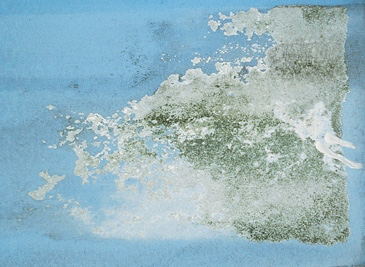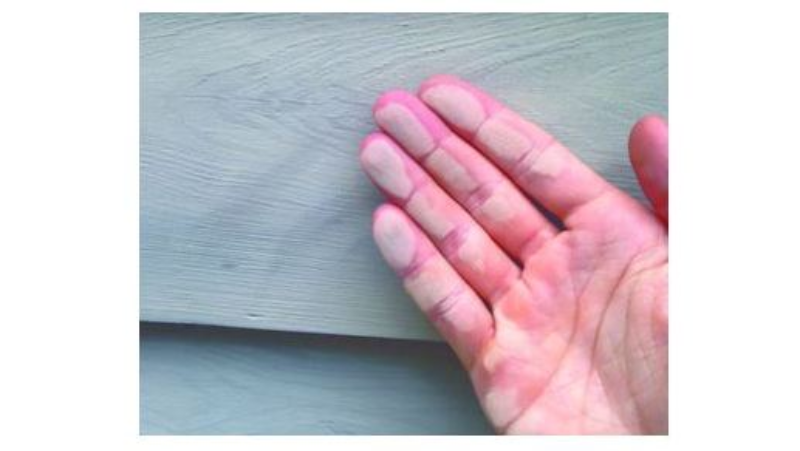Common Paint Failures and Their Solutions
- Kristin Ventura
- Sep 14, 2017
- 7 min read
Exterior paint fails for a large variety of reasons. Listed below are some of the most common paint failures and solutions. As always, we strongly suggest you contact us if your paint fails for the most professional solution and application.
Alligatoring Patterned cracking in the surface of the paint film resembling the regular scales of an alligator.
Possible Causes:
Application of an extremely hard, rigid coating, like an alkyd enamel, over a more flexible coating like a latex primer.
Application of a top coat before the undercoat is dry.
Natural aging of oil-based paints as temperature fluctuates. The constant expansion and contraction results in a loss of paint film elasticity.
Solution: Old paint should be completely removed by scraping and sanding the surface; a heat gun can be used to speed work up on a large surface but take care to avoid igniting the paint or substrate. The surface should be primed with high quality latex or oil-based primer, then painted with a top quality exterior latex paint.
Bleeding
Discoloration of the surface of the refinish color.
Possible Causes:
Old Finish releasing dye that comes to the surface.
Solution:
Remove all previous color coats. Prepare the surface for a sealing primer followed by a two coat finish. If previous coatings are difficult to remove; prepare the surface and follow with a blocking agent primer before applying a two coat finish.
Blistering Bubbles resulting from localized loss of adhesion and lifting of the paint film from the underlying surface.
Possible Causes:
Painting a warm surface in direct sunlight.
Application of oil-based or alkyd paint over a damp or wet surface.
Moisture escaping through the exterior walls (less likely with latex paint than with oil-based or alkyd paint).
Exposure of latex paint film to dew, high humidity or rain shortly after paint has dried, especially if there was inadequate surface preparation.
Solution: If blisters go down to the substrate, try to remove the source of the moisture. Repair loose caulking, consider installing vents or exhaust fans. Remove blisters. If blisters do not go all the way down to the substrate, remove them by scraping, then sanding; prime bare wood and repaint with a quality latex exterior paint.
Blushing
The finish turns milky immediately or shortly after application.
Possible causes:
Application in high humidity where moisture gets trapped in finish.
Unbalanced reducer in paint product.
Condensation on old surface.
Solutions:
If this occurs, the surface will need to be sanded and refinished. Add retarder to the paint and re-coat surface. To prevent this in the future, use a good quality retarder, avoid application during high humidity, ensure surface is clean and dry, and keep paint a surface room temperature.
Chalking Formation of fine powder on the surface of the paint film during weathering which can cause color fading. Although some degree of chalking is a normal, desirable way for a paint film to wear, excessive film erosion can result from heavy chalking.
Possible Causes:
Use of low-grade, highly pigmented paint.
Use of an interior paint for an outdoor application.
Solution: First, remove as much of the chalk residue as possible, scrubbing with a stiff bristle (or wire brush on masonry)and then rinse thoroughly; or use power-washing equipment. Check for any remaining chalk by running a hand over the surface after i dries. If noticeable chalk is still present, apply a quality oil-based or acrylic latex primer (or comparable sealer for masonry), then repaint with a quality exterior coating. If little to no chalk remains and the old paint is sound, no priming is necessary.
Checking/Cracking The splitting of a dry paint film through at least one coat of paint, which will lead to complete failure of the paint. Early on, the problem appears as hairline cracks; later, flaking of paint chips occur.
Possible Causes:
Use of a lower quality paint that has inadequate adhesion and flexibility.
Over thinning the paint or spreading it too thin. Poor surface preparation, especially when the paint is applied to bare wood without priming.
Painting under cool or windy conditions that make latex paint dry too fast.
Solution: It may be possible to correct cracking that does not go down to the substrate by removing the loose paint with a scraper or wire brush, sanding to feather edges, priming any bare spots and repainting. If the cracking goes down to the substrate, remove all of the paint by scraping and/or sanding and/or use of a heat gun; then prime and repaint with a quality exterior latex paint.
Dieback/Dull Finish
When a gloss finish becomes dull as film dries or ages.
Possible Causes:
Compounding before the solvent evaporates/cures.
No flash time between coats.
Topcoats being applied on wet or uncured undercoats.
Washing with harsh solvent cleaners.
Solution:
If problem as occurred after application then it will need to be sanded and refinished. During application, allow the coating to properly cure before applying additional coats.
Efflorescence/Mottling Crusty, white salt deposits, leached from mortar or masonry as water passes through it.
Possible Causes:
Failure to adequately prepare the surface by removing all previous efflorescence.
Excess moisture escaping through the exterior masonry walls from behind.
Solution: If excess moisture is the cause, eliminate the source by repairing the source and sealing any cracks in teh masonry with a high quality, water-based all-acrylic or siliconized acrylic caulk. If moist air is originating inside the building, consider installing vents or exhaust fans, especially in the kitchen, bathroom and laundry rooms. Remove the efflorescence and all other loose material with a wire brush, power brush or power washer; then thoroughly rinse the surface. Apply a quality water-based or solvent-based masonry sealer or primer an dallow it to dry completely. Then apply a coat of top quality exterior paint, masonry paint or elastomeric wall coating.
Fading/Poor Color Retention Premature and/or excessive lightening of the paint color which often occurs on surfaces with sunny southern exposure. Fading/poor color retention can also be a result of chalking of the coating.
Possible Causes:
Use of an interior grade of paint for an outdoor application.
Use of a lower quality paint, leading to rapid degradation (chalking) of the paint film.
Use of a paint color that is particularly vulnerable to UV radiation (most notably certain bright reds, blues and yellows).
Tinting a white paint not intended for tinting or over tinting a light or medium paint base.
Solutions: When fading/poor color retention is a result of chalking, it is necessary to remove as much of the chalk as possible. In repainting, be sure to use a quality exterior paint in colors recommended for exterior use.
Mildew Black, grey or brown areas of fungus growth on the surface of the paint or caulk.
Possible Causes:
Forms most often on areas that tend to be damp and receive little or no direct sunlight (walls with a northerly exposure and the underside of eaves are particularly vulnerable).
Use of a lower quality paint which may have an insufficient amount of mildewcide.
Failure to prime bare wood before painting.
Painting over a substrate or coating on which mildew has not been removed.
Solution: Test the paint to distinguish mildew from dirt by applying a few drops of household bleach to the discoloured area. If it disappears, it is probably mildew. Treat the mildew by applying a mixture of water and bleach: 3:1 and leave on the area for twenty minutes, applying more as it dries. Wear goggles and rubber gloves. Then scrub and rinse the area clean. Apply an exterior latex primer then a top-of-the line exterior latex paint.
Peeling (delaminating) Loss of paint due to poor adhesion. Where there is a primer and top coat or multiple coats of paint, peeling may involve some or all coats.
Possible Causes:
Seepage of moisture through uncaulked joints, worn caulk or leaks in the roof or walls.
Excess moisture escaping through the exterior walls (more likely if paint is oil-based).
Inadequate surface preparation.
Use of lower quality paint.
Applying an oil-based paint over a wet surface.
Earlier blistering of paint.
Solution: Try to identify and eliminate the source of the moisture. Prepare the surface by removing all the loose paint with the scraper or stiff wire brush, sand rough edges and apply appropriate primer. Repaint with a top quality acrylic latex exterior paint for best adhesion and water resistance.
Tannin Staining Brownish or tan discoloration on the paint surface due to migration of tannins from the substrate through the paint film. Typically occurs on "staining woods" such as redwood, cedar and mahogany or over painted knots in certain other wood species.
Possible Causes:
Failure to adequately prime and seal the surface before applying the paint.
Use of primer that is not sufficiently stain-resistant.
Excess moisture escaping through the exterior walls which can carry the stain to the paint surface.
Solution: Correct any possible sources of excess moisture. After thoroughly cleaning the surface, apply a high quality stain-resistant or acrylic latex primer. Oil-based stain-resistant primers are the best type to use on severely staining boards. In extreme cases, a second coat of primer can be applied after the first has dried thoroughly. Finish with a top quality latex paint.
Poor Galvanized Metal Adhesion Paint that has lost its adhesion to a galvanized metal substrate.
Possible Causes:
Improper surface preparation, such as inadequate rust removal.
Failure to apply a primer before application of an oil-based or vinyl latex paint.
Failure to sand baked-on enamel finishes or glossy surfaces before painting.
Solution: Any rust on the metal should be removed with a wire brush, then an acrylic latex corrosion-inhibitive primer should be applied (one coat is usually sufficient). Previously painted galvanized metal that is completely rust-free can be painted without applying a primer. A latex metal primer should be applied to unpainted galvanized metal, followed by a top quality exterior acrylic latex paint.
Pro-Tech Painting professionals can help with any of these issues. We will come out and inspect your paint issue and come up with a solution that is high quality and budget-friendly.
















































Comments